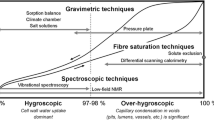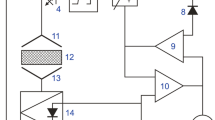Abstract
In many wood products manufacturing processes, it is important to ensure that the physical properties of the raw material lie within acceptable ranges and are measured reliably. It is also important for practical use that the measurement process is robust, low-maintenance, fast and preferably non-contacting. This paper describes the development and demonstration of a microwave system for simultaneously identifying wood grain angle, moisture and density. The method involves propagating a microwave beam through the wood and measuring the resulting depolarization, attenuation and phase shift. The wood physical properties can then be identified from these measurements. In a series of measurements, the prototype microwave system successfully identified wood grain angles for hemlock and Douglas fir respectively with standard errors of 0.9° and 2.5° (measured range = -90° to +90°), moisture content 1.2% and 1.9% (measured range = 7–28%), moisture density 3.7 kg/m3 and 7.9 kg/m3 (measured range = 40–150 kg/m3, and dry density 16 kg/m3 and 30 kg/m3 (measured range = 325–625 kg/m3).
Zusammenfassung
In vielen Bereichen der Holzbe- und -verarbeitung ist es wichtig, dass die Materialeigenschaften innerhalb zulässiger Bereiche liegen und die Eigenschaften zuverlässig gemessen werden. In der Praxis sollten diese Messverfahren robust, schnell, wartungsarm und möglichst berührungslos sein. In diesem Artikel wird die Entwicklung und Eignung eines Mikrowellensystems für die gleichzeitige Bestimmung von Faserneigung, Holzfeuchte und Rohdichte beschrieben. Bei dieser Methode wird das Holz mit Mikrowellen durchstrahlt und die dabei entstehende Depolarisierung, Schwächung und Phasenverschiebung gemessen. Anhand dieser Messungen können die physikalischen Holzeigenschaften bestimmt werden. Mit einem Prototyp gelang es die Faserneigung, die Holzfeuchte und die Rohdichte von Hemlocktanne und Douglasie zu bestimmen, und zwar lag die Faserneigung in einem Messbereich von -90° bis +90° mit einer Standardabweichung von 0.9° bzw. 2.5°, die Holzfeuchte in einem Messbereich von 7–28% mit einer Standardabweichung von 1.2% bzw. 1.9%, die Dichte der Feuchte in einem Messbereich von 40–150 kg/m3 mit einer Standardabweichung von 3.7 kg/m3 bzw. 7.9 kg/m3 sowie die Trockenrohdichte in einem Messbereich von 325–625 kg/m3 mit einer Standardabweichung von 16 kg/m3 bzw. 30 kg/m3.
Similar content being viewed by others
References
Anonymous (2001) Catalog 28-1, Metriguard, Inc, Pullman, WA, pp 53–54
Forest Products Laboratory (1999) Wood Handbook: Wood as an Engineering Material. USDA Forest Service
King RJ (1978) Microwave Homodyne Systems. Peregrinus Press, London, England
King RJ, James WL, Yen YY (1985) A Microwave Method for Measuring Moisture Content, Density and Grain Angle of Wood. In: Proc 1st Intl Conference on Scanning Technology in Sawmilling. Miller Freeman Publications, San Francisco, CA
King RJ, Basuel JG (1993) Measurement of Basis Weight and Moisture Content of Composite Boards Using Microwaves. For Prod J 43(9):15–22
Kraszewski A, Kulinski S (1976) An Improved Microwave Method of Moisture Measurement and Control. IEEE Trans Ind Electron Control Instrum 23(4):364–370
Leicester RH, Seath CA (1996) Application of Microwave Scanners for Stress Grading. In: 4th International Wood Engineering Conference, New Orleans, 2:435–440
Martin P, Collet R, Barthelemy P, Roussy G (1987) Evaluation of Wood Characteristics: Internal Scanning of the Material by Microwaves. Wood Sci Technol 21(4):361–371
McLauchlan TA, Norton JA, Kusec DJ (1973) Slope of Grain Indicator. For Prod J 23(5):50–55
Milota MR (1994) Specific Gravity as a Predictor of Species Correction Factors for a Capacitance-Type Moisture Meter. For Prod J 44(3):63–68
Orhan FB (2004) Estimating Wood Physical Properties by Using Microwave Measurements. MA Sc dissertation, Department of Mechanical Engineering, University of British Columbia, Vancouver, Canada
Tiuri M, Jokela K, Heikkila S (1980) Microwave Instrument for Accurate Moisture and Density Measurement of Timber. J Microwave Power 15:251–254
Torgovnikov GI (1993) Dielectric Properties of Wood and Wood-Based Materials. Springer-Verlag, New York
Wilson PJ (1999) Accuracy of a Capacitance-Type and Three Resistance-Type Pin Meters for Measuring Wood Moisture Content. For Prod J 49(9):29–32
Author information
Authors and Affiliations
Corresponding author
Rights and permissions
About this article
Cite this article
Schajer, G., Orhan, F. Measurement of wood grain angle, moisture content and density using microwaves. Holz Roh Werkst 64, 483–490 (2006). https://doi.org/10.1007/s00107-006-0109-9
Published:
Issue Date:
DOI: https://doi.org/10.1007/s00107-006-0109-9




